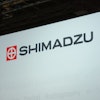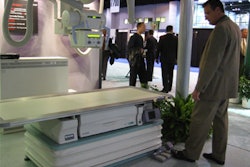CHICAGO - Eastman Kodak Health Imaging invested heavily in its healthcare information systems (HCIS) business in 2003, the results of which were evident in its booth at the 2003 RSNA meeting. The Rochester, NY-based vendor highlighted enhancements to its Web-based System 5 PACS architecture, an integrated RIS/PACS network, and new archive management software.
In PACS, Kodak is showing version 5.1 of its System 5 PACS program as a work-in-progress. Release 5.1 is designed to migrate existing Kodak PACS customers to the System 5 platform, said Gary Larson, general manager and VP, healthcare information services.
It includes features such as support for European and Asian languages, integrated 3-D processing capabilities, an automated MR window/level feature, orthopedic templates, as well as a common “look and feel” between the diagnostic station and Web software, Larson said. Version 5.1, which also provides for enterprise-wide viewing of “E-reports” that combine key images with radiology reports, is scheduled for release in the first quarter of 2004.
Kodak is also shedding light on the future roadmap for System 5. Version 5.2, shown as a work-in-progress, will bring additional flexibility and improved integration with third-party RIS networks.
It will also be able to run completely in a Windows environment, allowing customers a choice between Windows and Unix-based systems, Larson said. Other features include volume rendering and enhanced integration with computed radiography systems. Version 5.2 is slated for a late-2004 debut.
Kodak has inked more than a dozen contracts for System 5 in
The firm is also joining the RIS/PACS fray, thanks to the
Kodak rolled out Versatile Intelligent Patient Archive (VIParchive), software that manages PACS and cardiology storage needs. It can also provide enterprise-wide management of DICOM and non-DICOM images and information across multiple storage devices and locations, Kodak said.
VIParchive extends Kodak’s portfolio beyond radiology and into the healthcare information technology market, enabling IT managers to leverage shared storage systems across multiple applications, according to the vendor. Kodak acquired the software from Front Porch Digital earlier in 2003.
Also at the show, Kodak has formed a partnership with IBM. The firms said they would provide healthcare facilities with offerings that combine Kodak’s medical imaging products and services with IBM’s storage devices.
In addition, Kodak showed a mammography PACS network as a work-in-progress. The network, which leverages System 5’s architecture, will be able to manage and store full-field digital mammography (FFDM) images. It can function as a stand-alone system or as part of an enterprise-wide PACS, Kodak said.
In the last month, Kodak closed its acquisition of PACS
development partner Algotec, and created a new
headquarters for the HCIS operation in
Development efforts for the various HCIS components will
remain at Kodak’s various centers of excellence. For example, Algotec’s
Digital x-ray
In computed radiography, Kodak highlighted its DirectView CR 500 tabletop system, which is similar in image quality and productivity advantages to the DirectView CR, according to the vendor.
CR 500 handles more than 60 plates per hour, producing a review image in less than 60 seconds (based on 35 x 43-cm cassettes). Kodak said that CR 500 is an affordable option for smaller facilities implementing CR for the first time.
In digital radiography (DR), Kodak showed its
Kodak also showed a work-in-progress CAD program, developed by newly acquired medical application developer MiraMedica. While the CAD package will initially be used on digitized film studies, Kodak is developing a system for use in full-field digital mammography (FFDM) studies. The analog system is due out in 2004.
In film and imager developments, Kodak discussed the expansion of its DryView 8900 laser imaging system to support mammography images. The work-in-progress mammography option is scheduled for release in the second quarter of 2004, according to Gregory Cefalo, director of marketing, digital output systems.
In other news, DryView 8900 imagers will be available for purchase with one, two, or three drawers. That option will be ready in the second quarter of 2004.
Kodak has also introduced a new DryView laser imaging film that’s compatible with all DryView laser imaging systems. Replacing Kodak’s previous generation film, the new film offers greater visibility of subtle details due to lower noise and better density uniformity, Cefalo said.
X-Omat BT film is a new
blue-sensitive radiographic film for x-rays. Incorporating Kodak’s T-Grain
emulsion technology, the film offers better contrast, improved processing
stability, and reduction of handling-related artifacts. It’s
available now in the
Kodak highlighted its latest mammography film-screen system with enhanced visualization (EV) of subtle abnormalities in breast tissue. The vendor said that MIN-R EV screen film is an improvement over the company’s Kodak MIN-R 2000 film-screen system, containing a new asymmetric emulsion that provides high contrast and wide exposure latitude. This allows optimal exposure of glandular tissue without contrast loss in fatty areas and the breast periphery, Kodak said.
By Erik L. Ridley
and Robert Bruce
AuntMinnie.com staff writers
Related
Kodak
completes Algotec purchase, November 26, 2003
Kodak
bids for Algotec in push to expand PACS presence,
November 18, 2003
Kodak receives FDA approvable letter, November 11, 2003
Kodak lands large VA order, November 4, 2003
Copyright © 2003 AuntMinnie.com



















